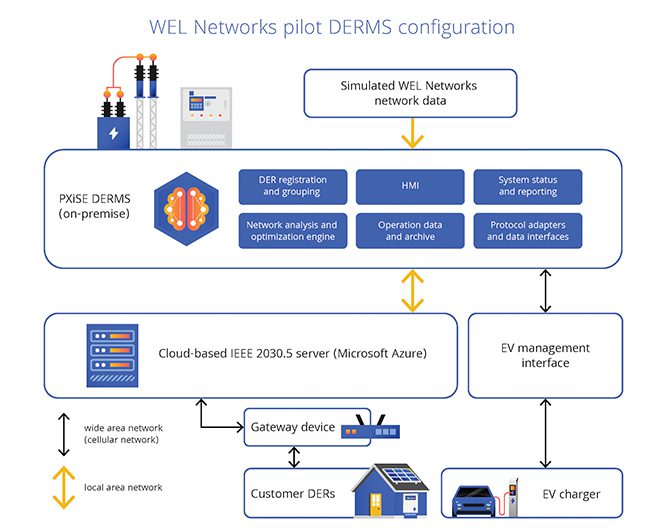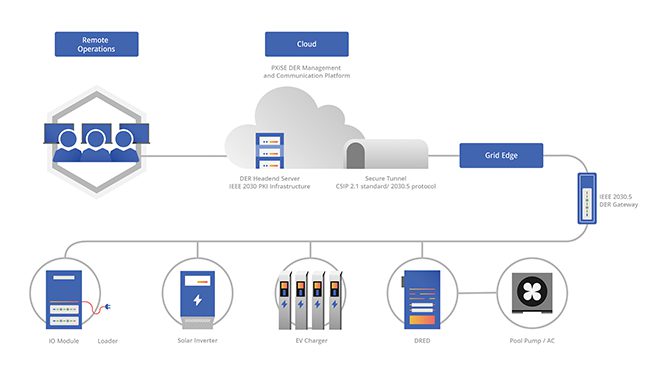New Zealand Utility Eyes Cloud Computing to Support Renewables, EVs
A New Zealand utility is piloting two software solutions to gauge their efficacy at handling grid constraints. Raglan is a beachside community of just under 4,000 people, about a two-hour drive from Auckland. Its grid is managed by WEL Networks, a utility serving roughly 100,000 customers in the surrounding Waikato region. While a historically stable population and no major industry meant WEL Networks’ infrastructure could meet the town’s energy needs through the year 2063, unanticipated changes forced the utility to revise its estimate for when the existing grid infrastructure would exceed capacity to 2028.
Some recent trends contributed to the revision—a rise in the rural population, a rise in the use of renewable energy, and an increase in the number of residents charging their electric vehicles (EVs) from the grid. Raglan’s coastal setting and the town’s proximity to several North Island population centers has increased the number of tourists, especially among those looking for less-developed beaches. The rise of remote work also is contributing to higher-than-expected population growth, and between the influx of tourists and sustainably minded residents, the number of EVs charging on WEL Networks’ grid has risen exponentially.
As EVs become more mainstream and accessible—New Zealand recently saw a surge in EV sales—Raglan’s townspeople are enthusiastically replacing their internal combustion vehicles and at the same time adopting residential solar. This is helping reduce carbon emissions but has led to challenges for WEL Networks. EVs are a unique drain on the grid when charging, and the unpredictability of where and when charging will occur makes it complicated for utilities to prepare for the increased loads. Between the growth in EVs, more visitors, and remote employees moving to the area, Raglan’s grid is being strained beyond WEL Networks’ expectations, and the utility needs a solution to manage the capacity of the grid before it turns to major capital upgrades.
WEL Networks decided to pilot two software solutions to manage the increase in EV chargers and household solar installations. The software would give the utility visibility into distributed energy assets on the grid and help maintain grid stability while deferring major infrastructure upgrades, such as moving beyond a single substation on the network.
 |
|
1. New Zealand utility WEL Networks, in a pilot program to help manage its grid network, tested this configuration of a distributed energy resource management system. Courtesy: PXiSE Energy |
The first pilot tested a distributed energy resource management system (DERMS, Figure 1). WEL Networks developed a virtual three-phase low-voltage distribution network that included a distribution transformer, associated low-voltage circuits, and customer connections. The pilot involved embedding monitored and controlled customer distributed energy resources (DERs) into a simulated unbalanced three-phase low-voltage network model, which then offered the advantage of being capable of testing expected DER operating scenarios and the control responses that are needed to manage network constraints.
The first phase of the pilot included a manual test of control from the on-premise DERMS to DERs at 11 customer sites consisting of four types of assets: solar photovoltaic (PV), battery storage, EV charger, and controllable load via a demand response enabling device (DRED). The DERMS was tested under the following three high-level network scenarios:
- ■ High–Distributed Generation, Low-Load Scenario. Tested the DERMS’ ability to manage the impacts of high levels of distributed generation when customer loads are low.
- ■ Low-Generation, High-Load Scenario. Tested the DERMS’ ability to manage the impacts of high customer loads.
- ■ Outage Management. Simulated specific outage scenarios within the virtual network to test constraint management with different network configurations.
For communication, the DERMS interfaced with customer DERs via a DER gateway at each site and used different protocols such as IEEE 2030.5, Modbus, and AS/NZS 4755. Communication occurred over the 3G and 4G cellular network. An EV charger management platform controlled the EV chargers via an API.
 |
|
2. This diagram provides a look at the equipment included in a grid edge control system for distributed energy resources. Courtesy: PXiSE Energy |
The second software solution WEL Networks piloted was a new grid management tool (Figure 2) from the same solutions provider. PXiSE Energy Solutions made history when it received the world’s first IEEE 2030.5 server certification for its DERMS in 2020, and the company this year launched its DER Management and Communication Platform, a software product that offers cloud-based communication and dispatch of DERs using the IEEE 2030.5 protocol.
Compared to a full DERMS, the DER Management and Communication Platform forgoes autonomous control to give operators visibility into, and manual control over, individual DERs. The platform communicates with DERs via the IEEE 2030.5 protocol, empowering utilities to monitor up to a million DERs through the simplified web-based interface. The software is available from the Microsoft Azure marketplace, which gives utilities an uncomplicated way to obtain awareness and management of the DERs on their network. The platform is particularly attractive to those beginning their DER management journey or those who’d like to test capabilities with a limited pilot.
WEL Networks indicated that the network topology grouping and ability to schedule controls among customer-defined DER groups were among the most valued features of the software platforms. In addition to offering visibility and control of DERs to manage distribution network constraints (thermal and voltage), both pilots provided the utility with an extensive dataset related to customer DERs, such as home solar systems, and insight into how and when these resources are being used. This disaggregated DER data facilitates more precise planning so the utility can direct grid resources more efficiently.
The data is pulled from the customer DERs via the IEEE 2030.5 protocol, a purpose-built communication protocol for managing DERs. This forward-looking protocol was designed to control today’s DERs (and those that may come in the future), and offers visibility and management of behind-the-meter assets like EVs and home solar. As Raglan’s residents plug more EVs into the grid and install PV panels on their roofs, WEL Networks will be able to track the growing number of distributed assets on its grid. With robust abilities to store, process, and analyze vast quantities of data, the cloud is an ideal direction for utilities to turn to when it comes to solving the problem of managing DERs on their grids.
—Tim Allen is president and CEO of PXiSE Energy Solutions.